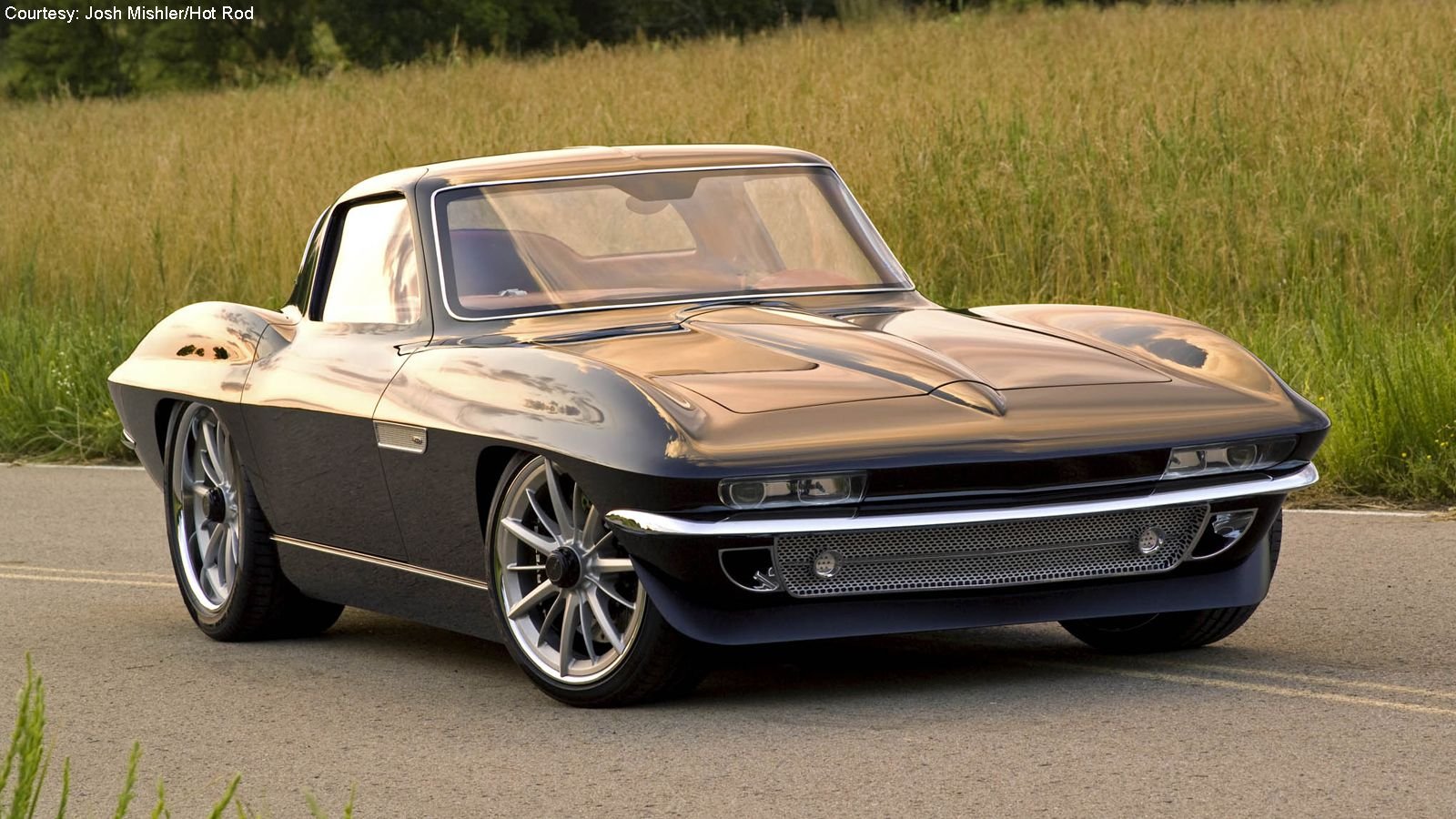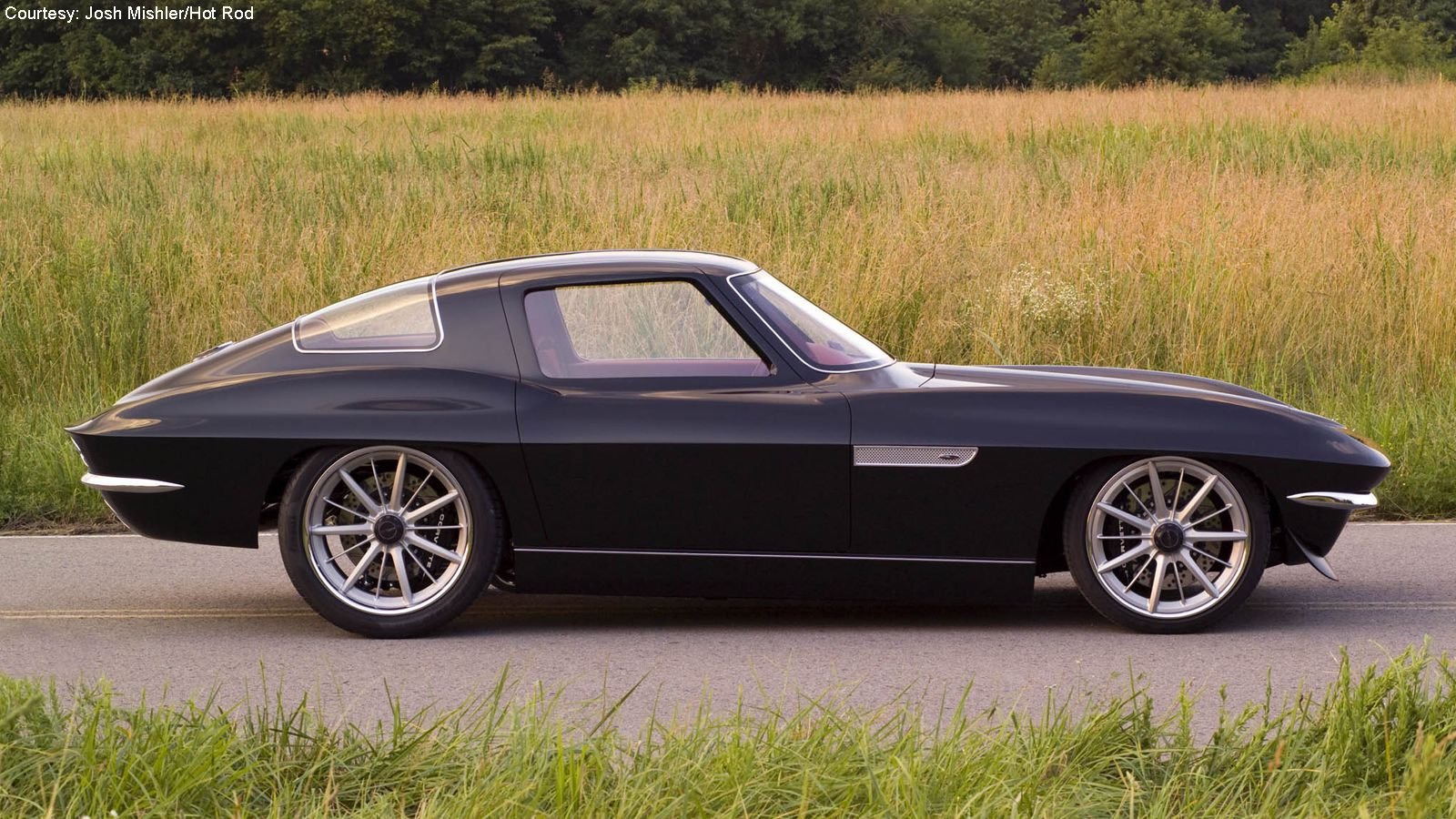Slideshow: 1965 C2 Sculpted to Perfection
This 1965 Corvette took parts from 5 separate cars, an LS7 engine, an SRIII tube frame, and almost 100 gallons of resin to get just right.


















Inspiration
Alan Woodall taught himself how to work with fiberglass while working on his first Corvette, a 1962 drag car. That was back in the '70s but his love for Corvettes began back in '63, when, as a college student, he saw his first split-window coupe. By the 2000s, Woodall had a few hot rods, including a '33 Ford, and he felt the time was right to finally get himself a C2, and to build it his own way, unlike any other C2 he had ever seen. By the early-2000s, prices for '63-'67 Corvettes hadn't been low for a long time, and since he knew he'd be modifying his potential purchase, he started searching for a body alone.
His first lead was an eBay Canada car, but after driving 900 miles to retrieve it, he discovered a car that didn't match its description—so he drove the 900 back home with an empty trailer. That must have earned him some good karma because two weeks later he found another body up for grabs—but this one was less than 10 miles from his house. The body was actually parts of five different bodies, and was basically just a shell— no engine, transmission, suspension, dash, trim, or frame—but it was just the start he needed.
Imagination
Though Woodall knew how to 'glass, he went to a trusted Corvette specialist to join the body sections together, and in 2005 he was ready to enter the sculpting phase of his build. His vision for the 'Vette incorporated the car's classic C2 lines, mixed with a more reserved Euro-style presentation. Over the course of the next three-and-a-half years, by Woodall's estimation, he went through 87 gallons of fiberglass resin on the Corvette's body, and another 11 to fabricate and modify interior pieces. During this process he realized he'd happily accept a bit of help, especially with the mechanical aspect of the build, so he started looking for a shop that fit that bill.
>>Join the conversation about this Jet Black 1965 C2 right here on LS1Tech.
Greening
The shop Woodall found was Greening Auto Company. He'd been following their work for some time, having met Jesse Greening when Jesse and his father Jeff won the Detroit Autorama Ridler Award with their (fiberglass) Salt Pounder coupe. A deal was struck, and as soon it appeared they would be creating something special, so did discussions of debuting the C2 at the Detroit Autorama. Woodall was an Autorama veteran himself, having won the Ridler award while working with the Peace family of Texas, in 2010, with a red Thunderbird. Woodall was down with the idea, and the project's attention to consequently ratcheted up a few notches.
>>Join the conversation about this Jet Black 1965 C2 right here on LS1Tech.
Chassis
Work on the chassis began with finding one. The 2.5-inch diameter tubular frame from SRIII selected as a base enables the use of a C5 front suspension and the rear suspension from a C4. Greening modified the frame's mounting points and narrowed both front and rear suspensions to allow the use of wider wheels and tires. Bilstein shocks and Baer 15-inch six-piston caliper disc brakes were installed at all four corners. The car's wheels (19×8.5 front and 20×10 rear) were custom designed for the build by Eric Brockmeyer and machined by Greening themselves. Sleek was the operative word as they also ground 125 separate frame welds smooth.
>>Join the conversation about this Jet Black 1965 C2 right here on LS1Tech.
Body
Turning attention back to the body, in addition to extra coats of resin to add strength, over 100 other changes were made—most of them subtractive rather than additive. A good portion of the Corvette's nose below the beltline crease was custom-fabricated so that a bespoke grille, headlights, and bumpers could be fit. The headlight lenses are custom-machined from acrylic, and the car was widened by about an inch.
>>Join the conversation about this Jet Black 1965 C2 right here on LS1Tech.
More Body
Out back, it was the same story. Another custom bumper was made, the recess for the license plate was raised, and the tail was reshaped without a dip and with a little more prominence. The plate light housing, taillight housings, and exhaust bezels were all custom-machined by Greening as well. They also smoothed out the 'Vettes flanks significantly, removing the vents behind the vehicle's front wheels. Other deletions include cowl vents and the door's wind wings. The latter change required totally redesigning the doors, adding more metal structure, and relocating the lower hinge to make room for new windows.
>>Join the conversation about this Jet Black 1965 C2 right here on LS1Tech.
Still More Bodywork
To match the slippery look of the rest of the car, the rear window was remounted semi-flush, requiring the use of hand-made trim. With every ounce gallon of bodywork finally finished, Jeff Greening and Jacob Edens painted the finished product with Glasurit Ink Black paint.
>>Join the conversation about this Jet Black 1965 C2 right here on LS1Tech.
Powerplant
His C2 wouldn't be the first such Corvette to receive a 427, though Woodall took advantage of 50 subsequent years of GM engineering and went with an LS7 for this particular C2—dishing out 421 hp and 385 lb/ft of torque at the rear wheels. Greening took the Smooth 'Vette theme the extra mile by dressing the engine and transmission external castings before they were assembled and/or painted. That transmission is a buttery six-speed 6L80E automatic, controlled by MasterShift electronic paddle shifters, and the car's exhaust is a sleek single-muffler two-and-a-half-inch system built by Stainless Works.
The engine bay is another exercise in minimalism, with custom-fabricated aluminum panels and covers concealing much of Greening's engine cosmetics handiwork. Even the underneath of the Sting Ray got the sleek treatment, with a polished driveshaft, and stainless brake lines that run inside, rather than below, the car.
>>Join the conversation about this Jet Black 1965 C2 right here on LS1Tech.
Consummation
While the C2's exterior is instantly recognizable as Corvette, the interior is much more loosely based on what once was. Greening fabricated a custom dash, console, package tray, and garnish moldings—all from fiberglass. Paul Atkins installed the square-weave carpet and covered the interior, including his own custom fiberglass seats, in red-with-silver leather. Dakota Digital gauges yield important info, while nearly all other functions are controlled via an ISIS touch-screen.
All told the project consumed 8,500 hours, and triple the amount of cash Woodall had originally allocated. Was it worth it? The pictures of the smooth Sting Ray should be confirmation enough, but just in case there's the car's top-eight Ridler award finish to help answer that question. But more than pictures or trophies, its the culmination of a dram that started in 1963, and that's just about priceless.
>>Join the conversation about this Jet Black 1965 C2 right here on LS1Tech.
For help with your maintenance and repair projects, please visit our how-to section in the forum.
